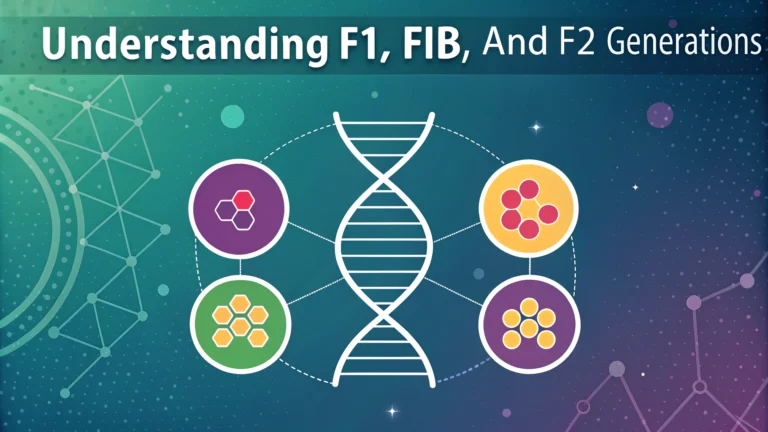F1, F1b, and F2 generations represent different breeding combinations in designer dog breeds, each with unique genetic characteristics.
F1 Generation Dogs
An F1 generation dog is the first-generation offspring of two purebred parent dogs from different breeds.
- Example: A Goldendoodle with one purebred Golden Retriever parent and one purebred Poodle parent
- Genetic makeup: 50% of each parent breed
- Usually displays hybrid vigor (enhanced health traits)
F1b Generation Dogs
F1b dogs result from breeding an F1 dog back to one of the original purebred parent breeds.
- Example: An F1 Goldendoodle bred back to a purebred Poodle
- Genetic makeup: 75% one breed, 25% other breed
- Often chosen for more predictable traits like coat type
F2 Generation Dogs
F2 generation results from breeding two F1 dogs together.
- Example: Two F1 Goldendoodles bred together
- Genetic makeup: Still 50-50 but with more variable trait expression
- Less predictable characteristics than F1 or F1b
Practical Breeding Considerations
| Generation | Trait Predictability | Common Uses |
|---|---|---|
| F1 | Moderate | Family pets, health-focused breeding |
| F1b | High | Allergy-friendly dogs, specific trait selection |
| F2 | Low | Genetic diversity programs |
Tips for Choosing the Right Generation
- Consider allergies: F1b generations often work better for allergy sufferers
- Think about grooming: Each generation can have different coat types
- Research health history: Ask breeders for genetic testing results
- Examine parent breeds: Understanding original breeds helps predict offspring traits
Contact reputable breed organizations or local kennel clubs for additional guidance on designer dog generations.
Always work with registered breeders who provide health certifications and genetic testing documentation.
Resources:
- American Kennel Club: www.akc.org
- Designer Dogs Kennel Club: www.ddkc.com
Health and Genetic Considerations
Understanding genetic health testing and inherited conditions is crucial when selecting designer dog generations.
- F1 generations typically show fewer inherited health issues
- F1b dogs may inherit specific health traits from the dominant breed
- F2 generations require careful health screening due to genetic variability
Training and Temperament
Different generations can exhibit varying behavioral traits and training responsiveness.
- F1 dogs often combine temperament traits from both parent breeds
- F1b dogs may show stronger behavioral characteristics of the backcrossed breed
- F2 puppies can display wide variations in temperament
Exercise Requirements
| Generation | Exercise Needs | Best Activities |
|---|---|---|
| F1 | Moderate to High | Mixed activities, versatile exercise |
| F1b | Varies by dominant breed | Breed-specific activities |
| F2 | Unpredictable | Adaptable exercise routine |
Conclusion
Selecting the right designer dog generation requires careful consideration of multiple factors:
- Personal lifestyle compatibility
- Specific trait requirements
- Health considerations
- Long-term care commitment
Success in designer dog ownership comes from matching the right generation to your specific needs while ensuring proper health screening and responsible breeding practices.
FAQs
- What are F1, F1b, and F2 generations in designer dog breeds?
F1 is the first-generation cross between two purebred dogs of different breeds. F1b is when an F1 hybrid is bred back to one of the original parent breeds. F2 is the result of breeding two F1 dogs together. - Which generation typically produces the most predictable results?
F1b generations typically produce the most predictable results because breeding back to a parent breed strengthens desired traits and creates more consistency in appearance and temperament. - Are F1 generation designer dogs healthier than purebreds?
F1 generations often benefit from hybrid vigor, which can result in better health due to a more diverse gene pool and reduced likelihood of inheriting breed-specific genetic disorders. - What does “hybrid vigor” mean in F1 crossbreeding?
Hybrid vigor, or heterosis, is the tendency of crossbred animals to have improved biological qualities compared to their purebred parents, including better health, resistance to disease, and longevity. - How consistent are F2 generation puppies in appearance?
F2 generation puppies typically show the most variation in appearance and traits because of genetic recombination, resulting in less predictable physical characteristics than F1 or F1b generations. - Why do breeders often prefer F1b generations for hypoallergenic dogs?
F1b generations, when bred back to the hypoallergenic parent breed, are more likely to inherit and express the non-shedding coat trait desired for allergy sufferers. - What health testing should be done for F1, F1b, and F2 breeding?
Breeding dogs should undergo health testing for conditions common to both parent breeds, including hip dysplasia, eye disorders, and genetic diseases specific to the breeds involved. - How do temperaments differ between F1 and F2 generations?
F1 generations typically show a blend of both parent breeds’ temperaments, while F2 generations can display more variable personality traits due to genetic recombination. - Can F1 generation dogs be registered with kennel clubs?
Most major kennel clubs like AKC and UKC don’t register F1 designer dogs in their main registries, though some organizations offer special registry options for mixed breeds. - What are the price differences between F1, F1b, and F2 puppies?
F1b puppies often cost more due to their more predictable traits and specialized breeding process. F1 puppies typically command mid-range prices, while F2 prices can vary based on breeder reputation and demand.












